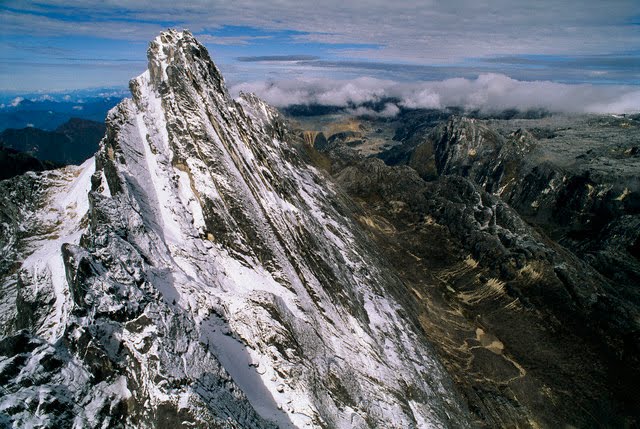Loss of habitat can result from climate change. It’s a complex issue because some insects and invertebrates actually depend upon icy conditions occurring to facilitate their lifecycle. There are even species of midges, earwigs and butterflies etc which are to be found only in the Arctic for instance.
The shrinking of the polar ice-caps and other glaciers has been well publicised. One of the less well-known glaciers, however, is the Carstensz Pyramid in Irian Papua (Western New Guinea). The first European to view it was the Dutch navigator Jan Carstenszoon in 1623. On a voyage from the spice-trading hub of Amboyna in the Moluccas, the snow-capped mountain range was spotted on an exceptionally clear day in what are generally overcast tropical seas. The mountain sits about 100 kms inland, yet Carstenszoon could clearly see it from out at sea which would be feasible with its summit rising to over 4,800 metres. A look at the world’s top 10 peaks (by landmass) shows just how significant Mount Carstensz is:
1. Eurasia – Chomolangma/Sagarmatha/Everest – 8,849 m
2. South America – Aconcagua – 6,961 m
3. North America – Denali/McKinley - 6,190 m
4. Africa – Kilimanjaro – 5,895 m
5. Antarctica – Vinson – 4,892 m
6. New Guinea – Nemangkawi Ninggok/Puncak Jaya/Carstensz - 4,884 m
7. Hawaii – Mauna Kea – 4,207 m
8. Borneo – Kinabalu – 4,095 m
9. Taiwan – Yu Shan - 3,952 m
10. Sumatra – Kerinci – 3,805 m
The Carstensz Pyramid comes in at number 6 whereas much more famous candidates such as Japan’s Fujiyama (3,776 m) and New Zealand’s Mount Cook/Aoraki (3,724 m) don’t even make the top 10.
Little is known of Jan Carstenszoon’s life but his
Journael op de ghedaene reyse van Nove Guinea was published in Amsterdam in 1624 and received a mixed response. His basic message was that there were no spices or minerals (the main interests of his Dutch East India Company employers) of any note in New Guinea. This was generally accepted although his suggestion of snow-capped mountains in Equatorial waters was roundly dismissed. Carstenszoon was also one of the first Europeans to reach the Australian mainland. His ships landed on the west coast of the Cape York peninsula although he thought that he was still on the coast of New Guinea. He thus missed mapping the crucial Torres Strait thru to the Pacific Ocean by a whisker.
By saying that there were no spices or minerals worth noting in New Guinea, he meant that the local people did not use spices in their cooking or practice metallurgy. This would have been sufficient information, however, because the reasoning would have been that had there been any spices or minerals, then the Javanese and the Arabs etc would already have been exploiting them. The Dutch and other Europeans thenceforth generally avoided the south-west Pacific in terms of mercantile trade. It wouldn’t be for another 150 years before the British and James Cook began to take a more active interest in that part of the world.

(The icy peak of the Carstensz Pyramid in New Guinea.)
In the intervening 400 years the Carstensz Pyramid glacier has contracted markedly meaning that the melted ice has lowered the hight of summit by several metres. More significantly, however, and quite ironically bearing in mind Carstensz’ report on the lack of minerals in New Guinea, is the fact that at the foot of the mountain today sits an opencast mine (one of the largest in the world and visible from space) extracting huge quantities of copper and gold.
